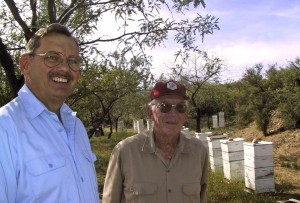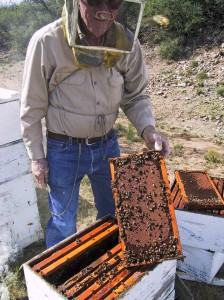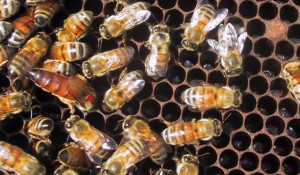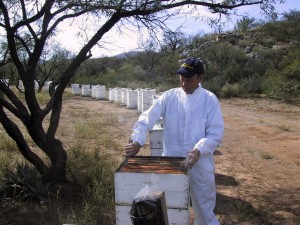 Erickson and Hines in test apiary 2003
Erickson and Hines in test apiary 2003
Dr Eric Erickson did a great job in the 1990’s in Arizona together with A.H. Atmowidjojo and Lenard Hines (commercial beekeeper with 700 colonies), first showing it’s relatively easy to identify more resistant bees and to maintain and develop a more resistant stock of bees without regular use of miticides.
In American Bee Journal, vol 138, no 11, 1998, they published their first article on this subject Can We Produce Varroa-Tolerant Honey Bees in the United States? The second article in ABJ, vol 139, no 12, 1999, Varroa-Tolerant Honey Bees Are a Reality. The third in ABJ, vol 140, no 8, 2000, with a headline like the one for this post.
In 2003 I visited Erickson and Hines together with Norwegian beekeeper Hans-Otto Johnsen. Erickson had retired. Hines were still working his bees but were significantly older than Erickson. At the Tucson lab they were focusing on an IPM-strategy against Varroa trying to identify natural compounds to be used as miticides.
Since then I have never heard anything about the work mentioned here. Why?
Though monitoring mite levels with alcohol wash identifying when to treat or removing a colony from an apiary which is used developing Varroa resistance is a method used frequently is such works, but not done the same way as Erickson, as far as I can understand. Yes, there are a growing number of beekeepers developing mite resistant bees. And there are other scientists, more than at the Louisiana lab? (thanks for those), that have been engaged, and are, in developing resistant bees (VSH and Russians). But have everyone forgotten about Erickson or why is his work ignored, or is it? Because there are Africanized bees in Arizona? Why would that be a reason for ignoring his work? Give a reason!
Now, his work included 733 samples, representing 118,512 bees washed and counted to determine Varroa infestation levels. Number of colonies in the three isolated test apiaries ranged in total between 36 and 71, lowest in early winter and highest in late spring following replacement of winter losses. Varroa levels were ranging between 0 and 50 per hundred bees, samples taken every second month. In average 7. The mite genotype was the ’Russian’ type said to be more virulant than the ’Japanese’ type.
All colonies were established in November 1995 and no colonies had been treated for at least 12 months at that time. When infestation rate was above 15 per 100 bees the colony was removed from the study and replaced by a colony with a daughter from one of the best colonies. Those were mated in the center apiary. Hines shifted queens in all his colonies to ’program’ queens. They maintained the program population from Nov 1994 to at least July 1999. First sampling for Varroa levels in 1995. 1998 was a good year and the three test apiaries averaged 90 pounds (40 kg) of honey per colony, which is a good crop in Arizona.
Hines said that after requeening with program queens in his entire operation he saw much less problems created by mites and in 1999 very little to zero indication of Varroa damage.
Concerning Africanization of the bees in Arizona the lab during two years studied nearly pure Africanized colonies in isolation and it found them to not be any less susceptible than the colonies in the selective breeding program. The earliest sources for the breeding program of more Varroa resistant bees were identified before the arrival of Africanized honey bees (AHB) to Arizona. They even found that a considerable number of AHB succumbed with Varroa damage appearing to be a major cause.
In 1999 the program stock of bees consisted of colonies of both European and African descent and their hybrids. Lenard Hines continued to eliminate from the breeding program any queen whose progeny tended to be overly defensive, without regard for their ancestry.
 Lenard Hines showing a very nice brood comb
Lenard Hines showing a very nice brood comb
When we visited Erickson and Hines in 2003 the colonies were worked with normal amount of smoke and no gloves. No cloud of bees was around us and it was no problem having a chat after checking the colonies, without hat and veil.
Erickson wrote that the lab was then in 1999 working to complete a three-step program to help beekeepers implement the results from this selection work into their own operation. The three-step program consisted of 1) this selection method they used, 2) using brood combs with smaller cell diameters as a management strategy to further reduce Varroa infestations, and 3) the use of natural products as miticides in an IPM-strategy to faciliate transitions from pesticide-based mite control to Varroa resistant populations. Such transitions are encouraged to be made in an area with a plan to expand the area.
You can today maybe see parts of this three step program here and there, but nowhere have I seen it described after the articles of Erickson in ABJ, why not? Has no one tried to get beekeepers to cooperate for this purpose? Is someone willing to fund such an effort, for example helping with federal/state/EU-money to breed queens and count mites and forming a coach group for beekeepers that want to decrease the use of chemicals and increase health and survival of their bees?


Eric, interesting story about the beginning of work for varroa resistant bees. You raised the question why nothing is heard about the work of Hines and Erickson after their publications in the 90-ies, which is a good question.
Don’t knowing these guys and their work, I would say OK what is their contribution and the value. You stated they have published about selection method for varroa resistant bees, which resulted in bees that were able to deal with varroa without the need of miticides. This was shown for local bees and with africanized bees. This is indeed good stuff!
From a practical perspective, a lot of beekeepers should be encouraged to copy this approach to avoid treatment and/or buying his resistant queens and integrate these in the own business. I can’t judge whether this is done???
From scientifical perspective, if their work was published one can look in scientific data base (e.g. Scifinder or others ) and can look how often their publications were cited by other authors. If they found something new, e.g. a sophisticated breeding approach or at least demonstrating something like that it is possible to breed resistant bees, they should be cited.
On the other hand, I realized that all people that deal with small cells, btw did Ericson and Hines use small cells because they interact with Lusby?, are somehow ignored by scientific people, as they feel they have several times shown that small cells have no impact on varroa. This is the same in Germany. I was discussing this with Erich Alfranseder, the guy who make the wax foundation presses. And he said our institutes have confirmed, that small cells have no impact. However, if I look to providers of foundations there are only a small bunch that can do really 4,9-er foundations and copnsequently a lot of studies used much too big foundations, but claiming these as small cells. Alfranseder attached a german study on one of his mails (actually a PhD thesis), but when I had a look at the details, they used plastic frames as small cell. We know that there are a lot of differences between the plastic frames and if they should have done this correctly, they should at least have integrate a big cell plastic frame hive as control.
Hence, most of these studies compare apples with pears and draw overhasty conclusions.
If I remember correctly you analyzed this in paper in great detail (thanks for this good work).
Maybe this is one reason, why their work is forgotten in the scientific area……..
Regards,
Rüdiger
Interesting comments Rüdiger
The first article was a scientific paper published under the heading Apicultural Research in ABJ, nov 1998. If it is published somewhere else I don’t know. Then two follow up articles were published in ABJ, one in 1999 and one in 2000. The latter in no 8, 2000. It was a description for others how ordinary beekeeperts could replicate their work. It deals with how to identify more tolerant colonies and then how to set up the work.
Erickson first cooperated with Lusby’s. But Erickson’s bees had problems drawing 4.9 and he made a halt going down from 5.1 to 4.9 due to the problems and hardcore Lusby didn’t like that so they stopped their cooperation. Erickson’s newsletter from 1997 on small cells is still on the usda homepage: http://www.ars.usda.gov/is/ar/archive/may97/honey.pdf
It seems small cells are some kind of a hot potato for scientists. As one PhD-student (nowadays a well-known internationell scientist) put it after investigating the issue:
“If small cell bees are more natural, which they well seem to be, and such bees function biologically somewhat different that large cell bees do, then the question will be how much of all scientific work on bees have to be re-done.”
Maybe it’s therefore the issue is a hot potato. No scientist has for example suggested:
“Well, we can in our tests see no advantage for small cells in connection with varroa mites, but as it is more natural and it doesn’t harm the bees, it’s not a bad idea for those that want to do the work involved, to regress their bees down to small cells.”
Concerning the test you refer to, I agree. Plastic small cell frames are good in that you take down the bees in one season. BUT, you can’t really use these colonies until next season in a test, as the bees has to adapt also epigenetically to their new environment, which will take at least one season, probably more. Then for the control colonies there are some options for large cell plastic frames, a greece one with 5.5 mm for example. Then you shouldn’t put test and control colonies in the same apiary (drifting and robbing spread mites and even out the mite populations) and not have other bees in the apiary, etc, etc
Back to Erickson and Hines. Hines used in his hives some combs with 5.1 mm cellsize and the rest bigger (5.4). Still they got these encouraging results. If you look carefully in their figures concerning the variation of the number of colonies in test at least in the beginning of the test the number went down a bit, but in the latter years concerning the experiences of Hines, the problems with mites decreased a lot. In the project they used no miticides. But how the articles are written give room for some use of miticides in the production hives of Hines.
It was 10 years ago I visited Erickson and Hines. I don’t know if Hines still has bees, or where his bees are today, if there are any left somewhere. But the articles about their work are still here.